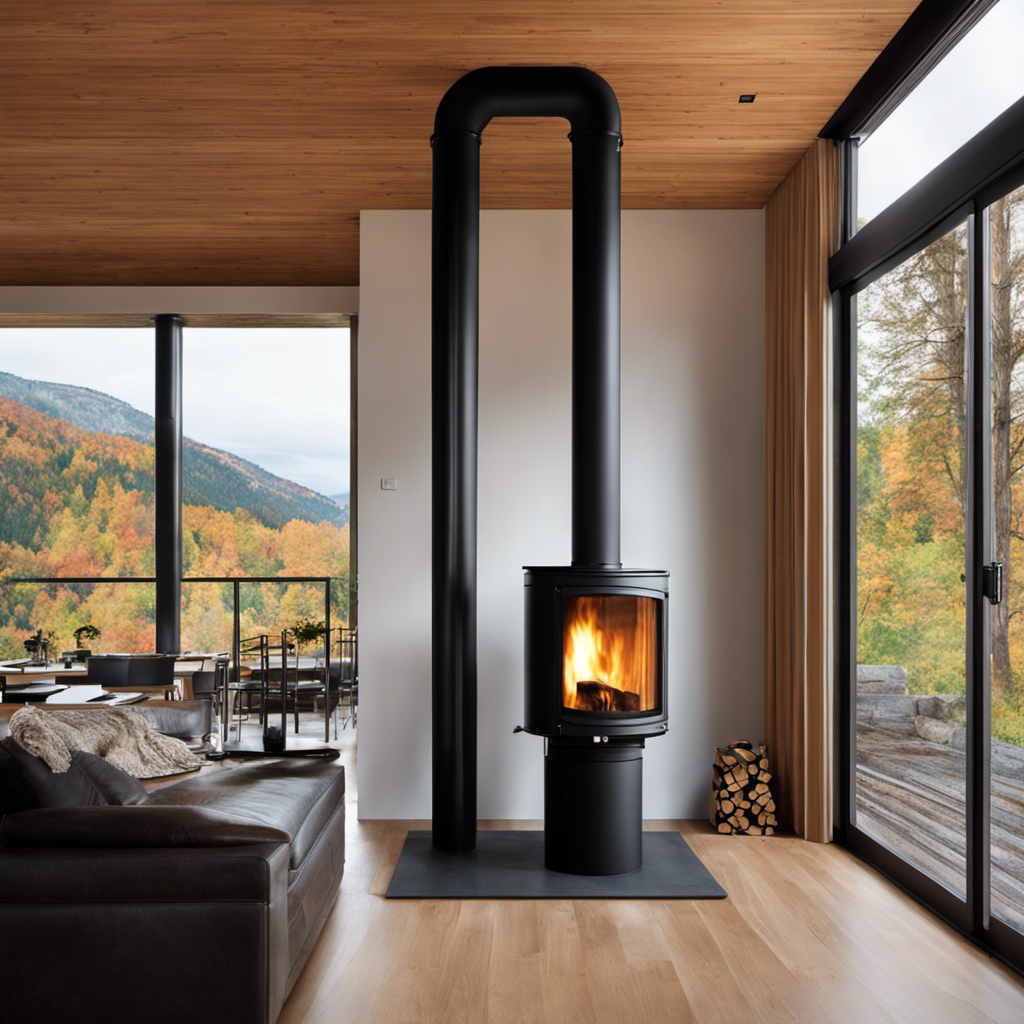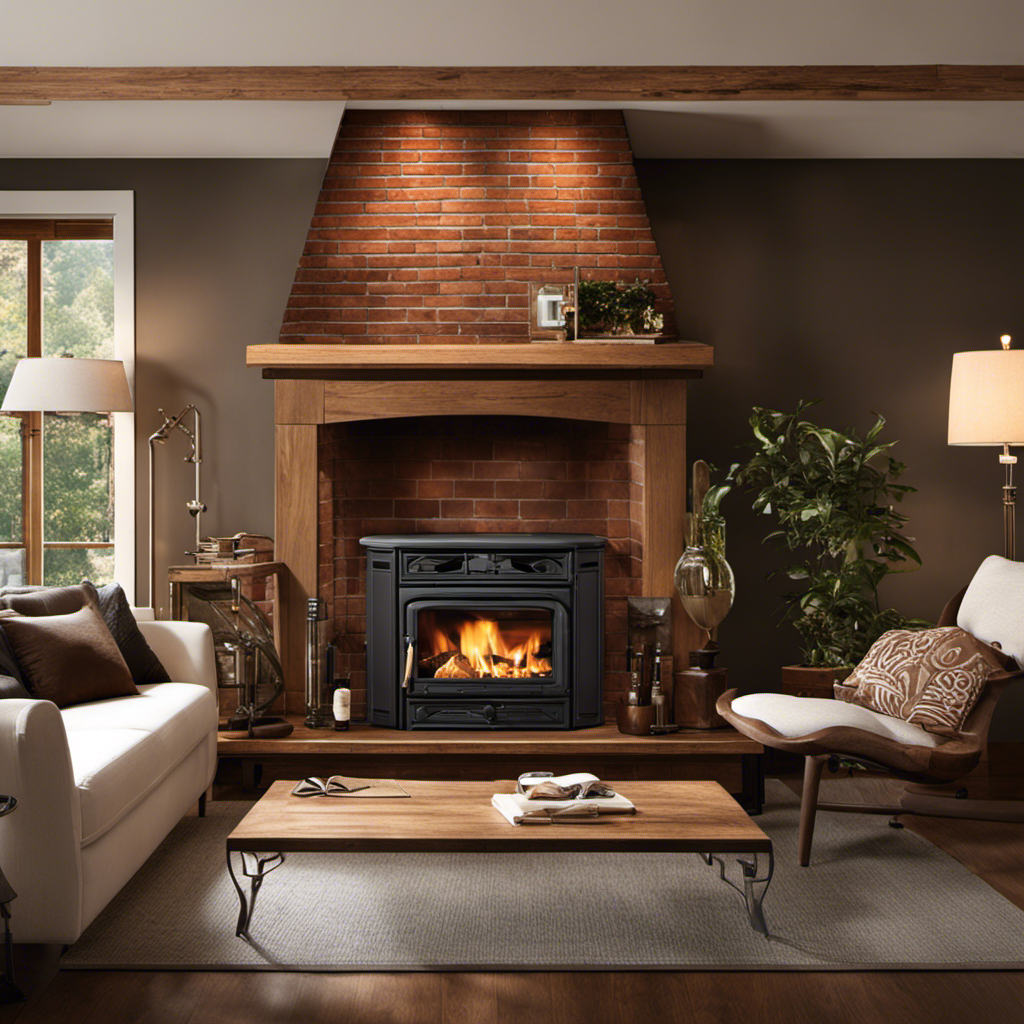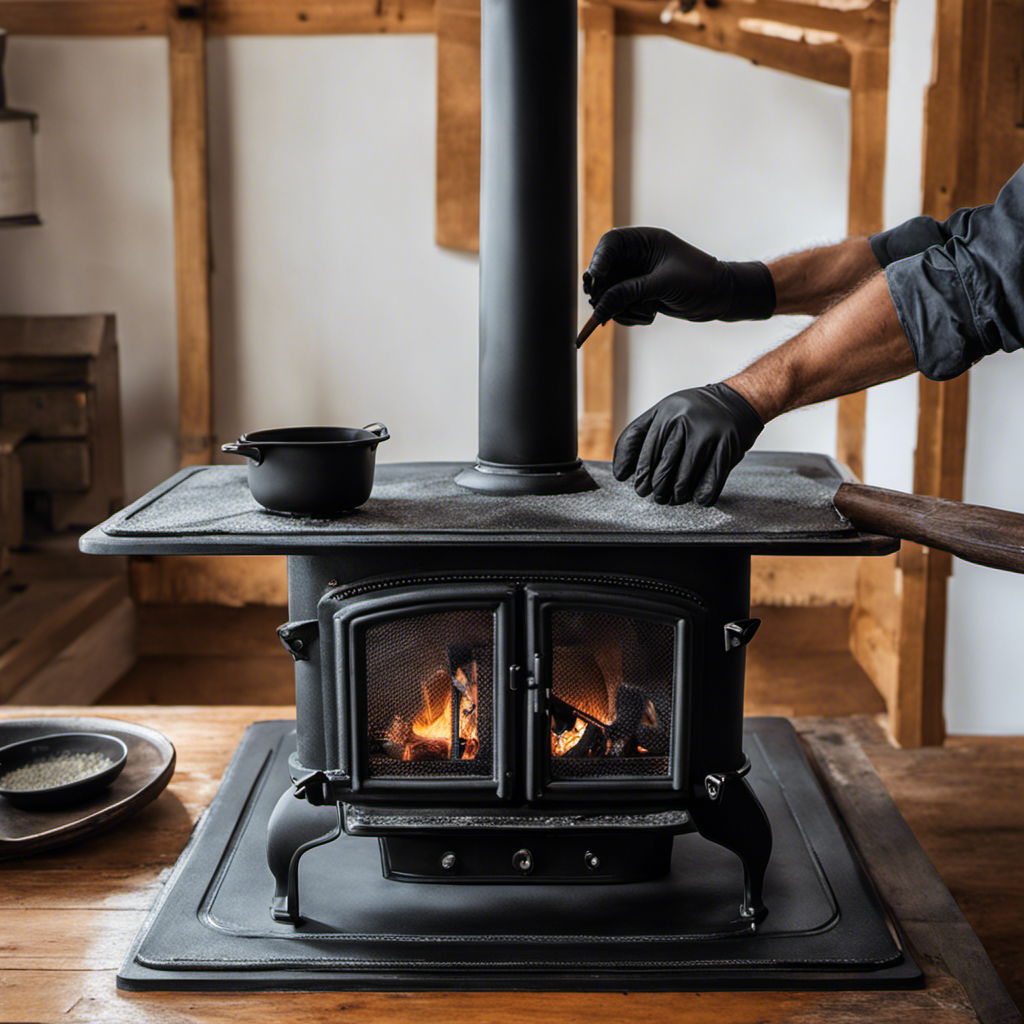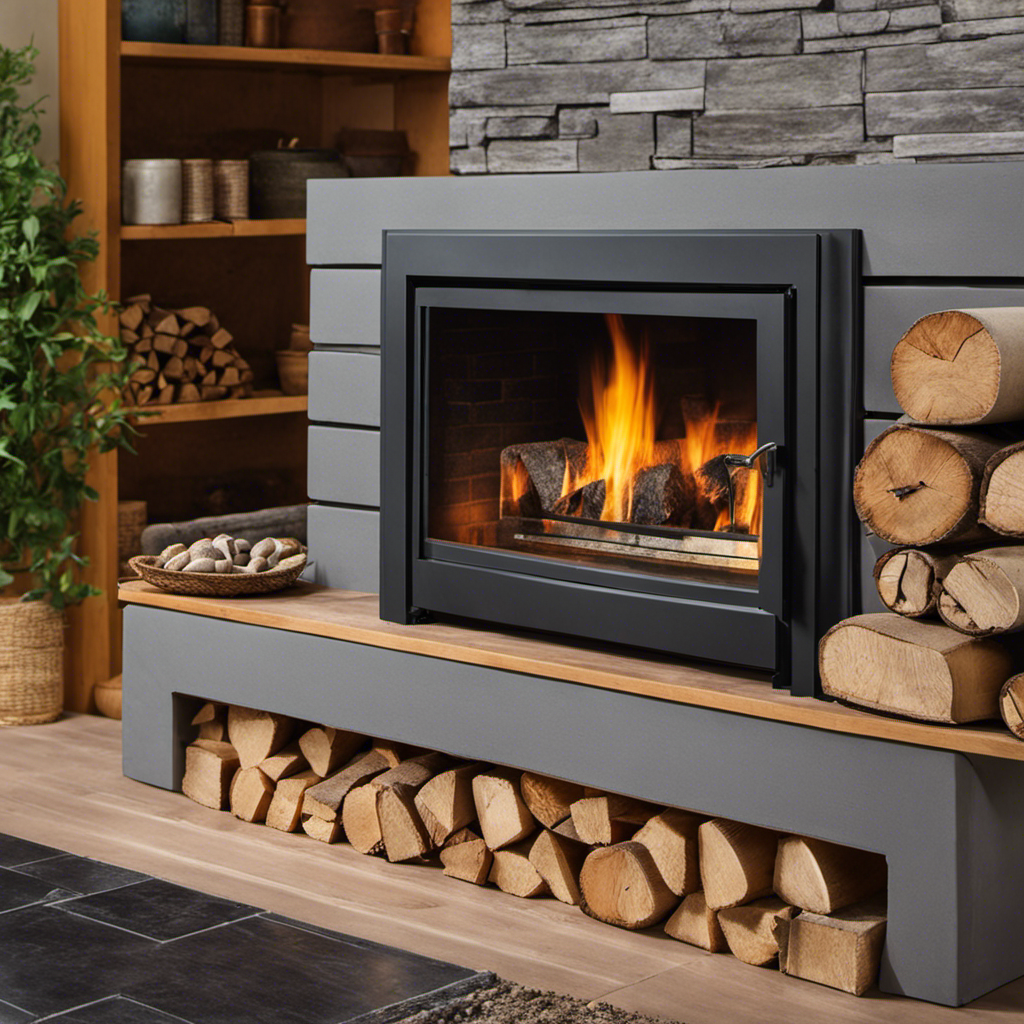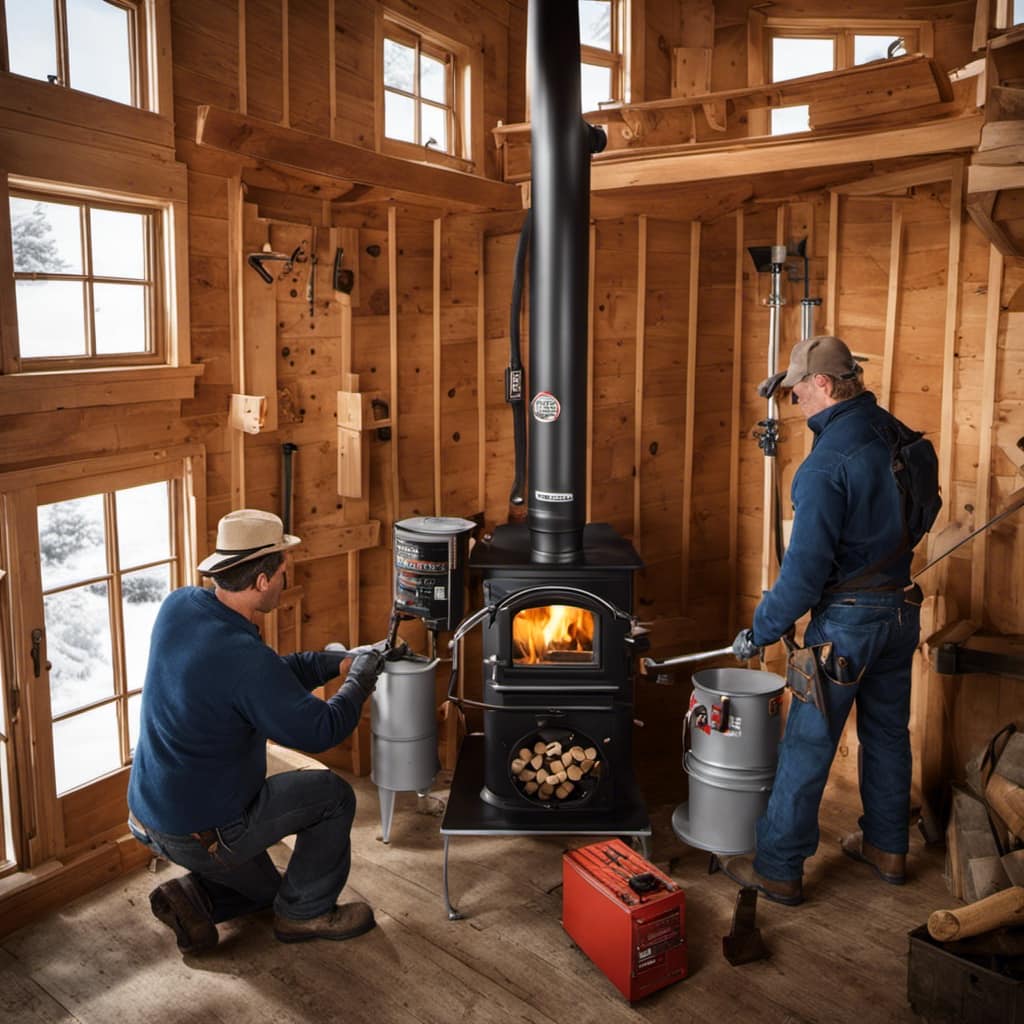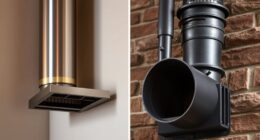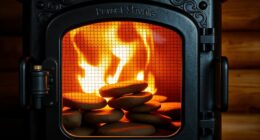Let me help you select the ideal chimney pipe for your wood stove. Trust me, choosing the right one is crucial to ensure your winter evenings are warm and pleasant.
With so many options available, it can be overwhelming. But fear not! In this article, I’ll break down the different types of chimney pipes, factors to consider, and even offer installation and maintenance tips.
Get ready to make an informed decision and enjoy the warmth of your wood stove to the fullest!
Key Takeaways
- Stainless steel chimney pipes are popular due to their durability and resistance to corrosion.
- It is important to choose a chimney pipe that matches the diameter of the stove’s flue collar.
- Insulation is crucial for maintaining high flue temperatures and preventing condensation.
- Balancing upfront cost considerations with long-term benefits and durability is necessary when choosing a chimney pipe.
Types of Chimney Pipes for Wood Stoves
I’m considering purchasing a stainless steel chimney pipe for my wood stove to ensure proper ventilation and safety. When it comes to chimney pipes for wood stoves, there are several types of materials to choose from.
One option is clay or ceramic pipes, which have been used for centuries. They’re durable and provide good insulation, but they can crack over time due to the high temperatures.
Another option is galvanized steel pipes, which are affordable and easy to install. However, they can rust and corrode over time, diminishing their lifespan.
Stainless steel chimney pipes, on the other hand, are known for their durability and resistance to corrosion. They’re also easy to clean and maintain. Overall, stainless steel chimney pipes are a popular choice due to their long lifespan and reliability.
Factors to Consider When Choosing a Chimney Pipe for a Wood Stove
There are three factors to consider when choosing a chimney pipe for a wood stove: material, size, and insulation.
When it comes to material, stainless steel is the most popular choice due to its durability and resistance to corrosion.
Next, sizing requirements play a crucial role in ensuring optimal performance of the wood stove. It’s important to choose a chimney pipe that matches the diameter of the stove’s flue collar.
Additionally, insulation is a key consideration as it helps to maintain high flue temperatures and prevent condensation.
When evaluating cost considerations, it’s essential to balance the upfront investment with long-term benefits and durability.
By carefully considering these factors, you can select the right chimney pipe for your wood stove that meets your sizing requirements while taking into account cost considerations.
Now, let’s delve into the different options of single-wall vs double-wall chimney pipes for wood stoves.
Single-Wall Vs Double-Wall Chimney Pipes for Wood Stoves
I prefer using double-wall chimney pipes for wood stoves as they provide better insulation and reduce the risk of condensation. When it comes to choosing the right chimney pipe for your wood stove, you have two options: single wall and double wall. Each option has its pros and cons.
Single-wall chimney pipes are made from a single layer of metal and are typically less expensive than double-wall pipes. They’re also easier to install due to their lightweight construction. However, single-wall pipes don’t provide the same level of insulation as double-wall pipes, which can lead to heat loss and increased energy consumption. Additionally, condensation is more likely to occur with single-wall pipes, which can lead to the formation of creosote and potential chimney fires.
On the other hand, double-wall chimney pipes consist of an inner and outer layer of metal with an insulating layer in between. This design provides better insulation, ensuring that the heat from your wood stove is efficiently transferred to your living space. The insulating layer also helps to reduce the risk of condensation, minimizing the formation of creosote and improving overall safety. However, double-wall pipes are generally more expensive and can be more challenging to install due to their heavier weight.
When it comes to materials, chimney pipes for wood stoves are commonly made from stainless steel or galvanized steel. Stainless steel is highly durable and resistant to corrosion, making it a popular choice for chimney pipes. Galvanized steel is also durable and cost-effective but may require regular maintenance to prevent rusting.
Insulated Chimney Pipes for Wood Stoves: Why They Are Important
Using insulated chimney pipes is essential for wood stoves because they help prevent heat loss and reduce the risk of chimney fires. Insulation benefits are crucial in maintaining the efficiency and safety of a wood stove.
When it comes to the materials used in insulated chimney pipes, there are a few options to consider:
-
Stainless Steel: This is a popular choice due to its durability and resistance to corrosion. It offers excellent heat retention and ensures maximum efficiency.
-
Double-Wall Construction: This type of chimney pipe consists of an inner and outer wall, with insulation in between. It provides superior insulation and minimizes the chances of condensation buildup.
-
Ceramic Fiber Insulation: This high-temperature insulation material is often used in insulated chimney pipes. It can withstand extreme temperatures and helps maintain optimal heat transfer.
-
Air Space: Some insulated chimney pipes have an air gap between the inner and outer walls. This air space acts as an additional layer of insulation, further reducing heat loss.
Installation and Maintenance Tips for Wood Stove Chimney Pipes
I’ve found that regular cleaning and inspection of my wood stove chimney pipe’s interior and exterior surfaces is crucial for maintaining its efficiency and safety.
When it comes to cleaning wood stove chimney pipes, there are a few tips that I’ve learned along the way. First, it’s important to use a chimney brush specifically designed for the size of your pipe. This will ensure that you can effectively remove any creosote buildup.
Additionally, be sure to clean both the inside and outside of the pipe, as debris can accumulate on the exterior as well.
Another common problem with wood stove chimney pipes is the formation of cracks or leaks. Regular inspections will help you identify any issues early on, allowing for prompt repairs.
Frequently Asked Questions
What Are the Different Types of Wood Stoves That Require Specific Chimney Pipe Types?
There are different types of wood stove designs that require specific chimney pipe types. When considering a wood stove, it is advantageous to use a double wall chimney pipe for added safety and improved performance.
Can I Use a Single-Wall Chimney Pipe for a Wood Stove That Is Located in a Tight Space?
In a tight space, using a single-wall chimney pipe for a wood stove can be challenging. It may not provide adequate insulation, leading to heat loss and potential safety risks. Consider using insulated chimney pipe for better performance and safety.
Are There Any Specific Regulations or Codes That I Should Be Aware of When Installing a Chimney Pipe for a Wood Stove?
When installing a chimney pipe for a wood stove, it’s crucial to be aware of the regulations and codes that govern the installation process. Additionally, specific requirements exist for chimney pipes in tight spaces.
Can I Use an Insulated Chimney Pipe for a Wood Stove if My House Is Not Well Insulated?
Using an insulated chimney pipe for a wood stove can provide many benefits, such as improved efficiency and reduced heat loss. However, if your house is not well insulated, there are alternatives to consider.
How Often Should I Clean and Maintain My Wood Stove Chimney Pipe to Ensure Optimal Performance?
To ensure optimal performance, it is important to clean and maintain your wood stove chimney pipe regularly. Troubleshoot common problems and properly measure and size the chimney pipe for your wood stove.
What Type of Insulation is Recommended for a Wood Stove Chimney Pipe?
When considering insulation options for wood stove chimney, it is vital to prioritize safety and efficiency. Insulated stainless steel chimney pipes are recommended, as they help retain heat and reduce the risk of fire hazards. Insulation ensures maximum heat retention while preventing condensation buildup. Premium insulation options for wood stove chimneys provide optimal performance and peace of mind for homeowners.
Conclusion
After considering the types of chimney pipes available, the factors to consider, and the importance of insulation, it’s clear that choosing the right chimney pipe for a wood stove is crucial.
The installation and maintenance of the chimney pipe are equally important to ensure safe and efficient operation.
By selecting the appropriate chimney pipe and following proper installation and maintenance guidelines, you can enjoy the warmth and comfort of your wood stove for years to come.
Growing up surrounded by the vast beauty of nature, Sierra was always drawn to the call of the wild. While others sought the comfort of the familiar, she ventured out, embracing the unpredictable and finding stories in the heartbeat of nature.
At the epicenter of every remarkable venture lies a dynamic team—a fusion of diverse talents, visions, and passions. The essence of Best Small Wood Stoves is crafted and refined by such a trio: Sierra, Logan, and Terra. Their collective expertise has transformed the platform into a leading authority on small wood stoves, radiating warmth and knowledge in equal measure.

